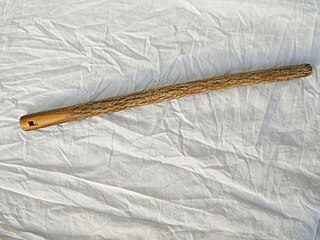Jan Marmenout | |
|---|---|
| Born | Ghent, Belgium |
| Genres | Ethnic |
| Occupation(s) | Instrumentalist, percussionist |
| Instruments | berimbau kalimba balafon didgeridoo shawm Tibetan trumpet conch shells fujara lithophones shruti box |
| Labels | Highgate Music |
Jan Marmenout (born in Ghent, Belgium) is a Belgian percussionist and multi-instrumentalist playing such instruments as the berimbau, kalimba, balafon, didgeridoo, shawm, Tibetan trumpet, conch shells, fujara, lithophones, etc. He is perhaps most-known for his compositions on the fujara, an ethnic instrument from Slovakia. Marmenout plays the fujara in an intuitive and non-traditionalist way.
He has composed the score for two movies, Judentransport XX (2003) and Desperado (2002).

Antoine-Joseph "Adolphe" Sax was a Belgian inventor and musician who created the saxophone in the early 1840s, patenting it in 1846. He also invented the saxotromba, saxhorn and saxtuba. He played the flute and clarinet.

A carillon is a pitched percussion idiophone that is played with a keyboard and consists of at least 23 cast bronze bells in fixed suspension and tuned in chromatic order so that they can be sounded harmoniously together. Usually housed in a bell tower and owned by churches, universities, or municipalities, the bells are struck with clappers, which are connected to a keyboard of wooden batons played with the hands and pedals played with the feet. Often, carillons include an automatic system through which the time is announced and simple tunes are played throughout the day.

The music of Slovakia has been influenced both by the county's native Slovak peoples and the music of neighbouring regions. Whilst there are traces of pre-historic musical instruments, the country has a rich heritage of folk music and mediaeval liturgical music, and from the 18th century onwards, in particular, musical life was influenced by that of Austria-Hungary. In the 19th century, composers such as Ján Levoslav Bella began to write romantic music with a Slovak character. In the twentieth century, there were a number of composers who identified with Slovak culture. After the fall of communism in 1989–90 the country also began to develop its own popular music scene in Western style.

Hillel Slovak was an Israeli-American musician best known as the founding guitarist of the Los Angeles rock band Red Hot Chili Peppers, with whom he recorded two albums. His guitar work was rooted in funk and hard rock, and he often experimented with other genres including reggae and speed metal. He is considered to have been a major influence on the Red Hot Chili Peppers' early sound.

The cimbalom is a type of chordophone composed of a large, trapezoidal box with metal strings stretched across its top. It is a musical instrument commonly found in the group of Central-Eastern European nations and cultures, namely contemporary Hungary, Slovakia, Czech Republic, Serbia, Croatia, Romania, Moldova, Ukraine, Belarus, Poland, and in the traditional instrumental music of East European Jews throughout most of that territory. It is also popular in Greece and in Romani music. The cimbalom is (typically) played by striking two beaters against the strings. The steel treble strings are arranged in groups of 4 and are tuned in unison. The bass strings which are over-spun with copper, are arranged in groups of 3 and are also tuned in unison. The Hornbostel–Sachs musical instrument classification system registers the cimbalom with the number 314.122-4,5. Moreover, the instrument name “cimbalom” also denotes earlier, smaller versions of the cimbalom, and folk cimbaloms, of different tone groupings, string arrangements, and box types.

A folk instrument is a musical instrument that developed among common people and usually does not have a known inventor. It can be made from wood, metal or other material. Such an instrument is played in performances of folk music.
The willow flute, also known as sallow flute, is a Nordic folk flute, or whistle, consisting of a simple tube with a transverse fipple mouthpiece and no finger holes. The mouthpiece is typically constructed by inserting a grooved plug into one end of the tube, and cutting an edged opening in the tube a short distance away from the plug.

An overtone flute is a type of a flute that is designed to play in the upper harmonics, typically well above the two or three harmonics that are the practical limit for most woodwind instruments.

A pipe is a tubular wind instrument in general, or various specific wind instruments. The word is an onomatopoeia, and comes from the tone which can resemble that of a bird chirping.

The fujara originated in central Slovakia as a large sophisticated folk shepherd's overtone fipple flute of unique design. It is technically a contrabass in the tabor pipe class.

Koncovka is a Slovak duct-blown overtone fipple flute without finger holes, traditionally played by shepherds. The koncovka flute is played by closing and opening the bottom hole of the flute. By increasing the air speed, two different harmonic series of notes can be played with the end either open or closed. Traditional koncovka melodies use the partial Lydian scale available on this instrument.

The three-hole pipe, also commonly known as tabor pipe or galoubet, is a wind instrument designed to be played by one hand, leaving the other hand free to play a tabor drum, bell, psalterium or tambourin à cordes, bones, triangle or other percussive instrument.
Popular music began to replace folk music in Slovakia beginning in the 1950s, when Slovakia was a part of Czechoslovakia; American jazz, R&B, and rock and roll were popular, alongside waltzes, polkas, and czardas, among other folk forms. By the end of the 1950s, radios were common household items, though only state stations were legal. Slovak popular music began as a mix of bossa nova, cool jazz, and rock, with propagandistic lyrics. Dissenters listened to ORF, Radio Luxembourg, or Radio Free Europe, which played more rock. Czechoslovakia was more passive in the face of Soviet domination, and thus radio and the whole music industry toed the line more closely than other satellite states.

Ustad Sabri Khan was an Indian sarangi player, who was descended on both sides of his family from a line of distinguished musicians.

The Moon and the Nightspirit is a Hungarian folk music duo founded in 2003 by Ágnes Tóth and Mihály Szabó. Their songs deal mostly with pagan fairy tales and shamanism.
Fonó Zenekar, the Fonó Folk Band is a Hungarian folk band, playing traditional Hungarian music.
Dirtwire is an American band consisting of David Satori, Evan Fraser, and Mark Reveley, all of whom play a variety of uncommon musical instruments. They perform a form of experimental music that incorporates electronic music and instruments from around the world.